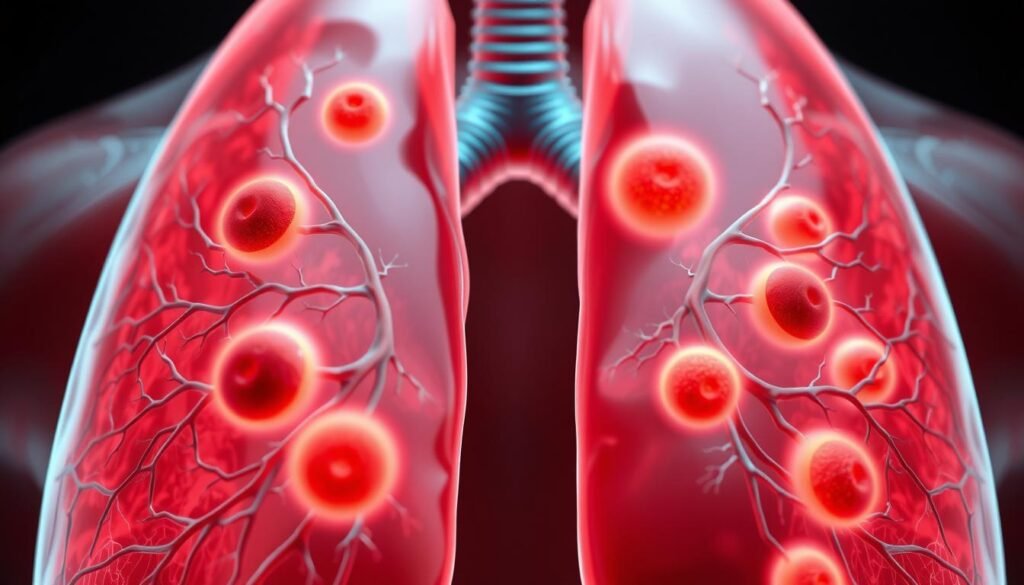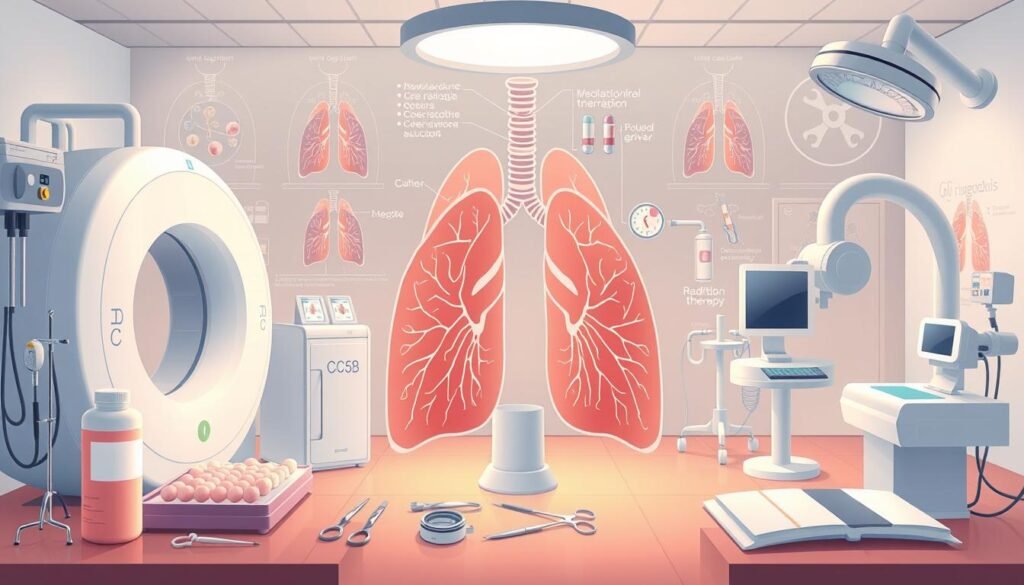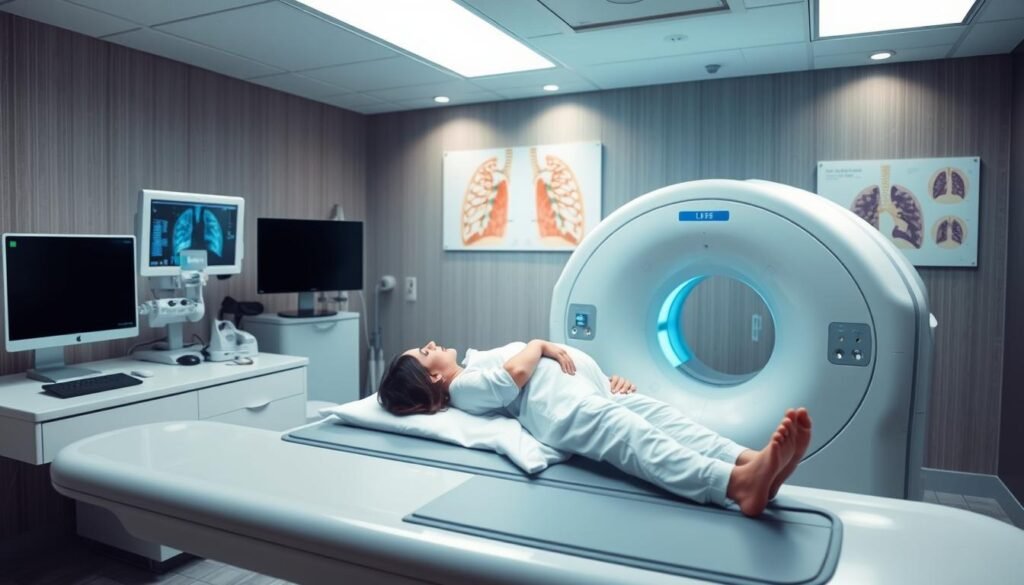About 95% of lung nodules aren’t cancer. They’re small growths found during scans like CTs or X-rays. They can worry patients and doctors. But it’s important to know the difference between harmful and harmless nodules. This helps with early diagnosis and treatment. Let’s explore the truth about lung nodules, their common causes, and treatment, to see if lung nodules are really cancer.
Key Takeaways
- About 95% of lung nodules are benign and stem from conditions like scar tissue or past infections.
- Nodules smaller than 1 cm generally have a low probability of being cancerous.
- Lung nodules with jagged edges are more likely to indicate cancer than those that are rounded.
- Calcified nodules often signal a noncancerous status due to calcium deposits.
- Lung cancer screening is recommended for individuals aged 50 to 80 with a significant smoking history.
What are Lung Nodules?
A lung nodule is a small, dense mass in the lung, usually less than 3 cm big. They show up as white spots on chest X-rays or CT scans. It’s crucial to know about the types of lung nodules. This is because they can point to different health issues, including cancer. The size, shape, and density of a nodule can tell us a lot about it.
Definition and Characteristics
Lung nodules can be benign or malignant. Most of them are not cancerous. They tend to be small, grow slowly, and have a smooth, round look. Cancerous nodules, however, might grow quickly and look bumpy or spiky. Recognizing these features helps doctors figure out the best plan of action. Smoking and radon gas exposure play a big role in increasing lung cancer risks.
How Lung Nodules are Detected
Lung nodules are often found by accident during scans for other health issues. High-risk individuals getting cancer screens may also discover them. In fact, chest imaging shows lung nodules in about half of adults. If doctors find nodules that look suspicious, they might do more tests like EBUS-TBNA. This helps understand what the nodules are. Regular CT scans can also track benign nodules to make sure they don’t get worse. Knowing about lung nodules is key. It highlights the importance of spotting early signs of lung cancer. Early detection can greatly improve treatment success.
Common Causes of Lung Nodules
Lung nodules come from various sources, each with different implications. It’s vital to know these causes because some are linked to lung cancer. Below, we outline key sources of lung nodules.
Scar Tissue from Past Infections
After infections like tuberculosis or pneumonia, scar tissue may form. This can appear as nodules on lung scans, leading to worry. These nodules usually do not mean cancer but need watching.
Inflammatory Conditions
Lung nodules can also come from inflammatory diseases. Rheumatoid arthritis and sarcoidosis are examples that may cause nodules, often found by chance. Knowing this helps identify lung cancer risks in those with ongoing inflammation.
Impact of Lung Irritants
Being around lung irritants is another big cause of lung nodules. Things like pollution, cigarette smoke, and job-related dangers can harm lungs and cause nodules to develop. People who smoke a lot have a higher chance of lung cancer. They should get checked often to catch any signs of cancer early.
| Cause | Description | Relation to Lung Cancer Risk |
|---|---|---|
| Scar Tissue from Infections | Results from past infections like tuberculosis or pneumonia | Generally benign, needs monitoring |
| Inflammatory Conditions | Includes rheumatoid arthritis, sarcoidosis | May indicate increased lung cancer risk for chronic cases |
| Lung Irritants | Pollution, smoke, and occupational exposures | Significantly raises lung cancer risk factors |
Incidental Findings: Understanding Lung Nodules
Sometimes, lung nodules are found during scans meant for other health issues. These nodules are mostly not cancerous but still need close watch. They can show if more tests are needed.
What Are Incidental Pulmonary Nodules?
Incidental pulmonary nodules are small lung growths spotted in imaging tests, like chest CT scans. Up to 30% of these scans might show a nodule or more. Studies, like the National Lung Screening Trial, found 96% of these nodules are not cancer, especially if they’re bigger than 6 mm. Smaller nodules, under 6 mm, usually don’t need further checks.
How They Differ from Cancer Screening Findings
These nodules differ from ones found in cancer screenings. They’re handled differently once spotted. Healthcare teams follow specific guidelines, like Lung-RADS, to watch these nodules. This helps them spot any tiny changes in size, even as little as 1–2 mm. This careful monitoring makes sure no nodule is missed.
Are Lung Nodules Cancerous?
Lung nodules often raise concerns about cancer. Many are benign, but some can indeed be cancerous. Knowing how often cancer occurs in lung nodules is key for those concerned.
Frequency of Cancer in Lung Nodules
Out of every 500 chest x-rays, 1 shows pulmonary nodules. Around 40% of these nodules might be cancerous. Survival rates vary, with many living more than five years after being diagnosed. For small nodules, less than one centimeter, survival after five years can be up to 80%.
Benign nodules often come from past infections and usually don’t grow much. Cancerous ones, on the other hand, tend to grow quickly, sometimes doubling in size every four months.
Factors Influencing Cancer Risk
Key factors include a person’s age and smoking history, with risks increasing for those over 35. The danger is even more significant for people aged 50 to 80 who have smoked a lot. Interestingly, most pulmonary nodules are found by chance during routine x-rays or CT scans. Options for dealing with these nodules range from watchful waiting to surgery. Regular low-dose CT scans are crucial for early detection and reducing the risk of lung cancer death.

Lung Nodule Diagnosis
Figuring out if lung nodules are benign or something serious is key. Imaging tests like CT and PET scans help a lot. They show the nodule’s details, which decides if we need more tests for lung cancer symptoms.
Imaging Techniques Used
To look at a lung nodule, doctors often use:
- CT scans
- PET scans
These scans show the nodule’s size and shape. They reveal how it grows which might mean cancer. Most people’s chest X-rays or CT scans find nodules. But, less than 5% are cancer.
Importance of Biopsies
If scans make doctors worried, a biopsy helps. A biopsy takes a small piece of the nodule. It’s done with:
- Bronchoscopy
- Needle aspiration
By checking the biopsy, doctors can see if it’s cancer. Age, family cancer history, and symptoms guide treatment decisions. This helps manage nodule diagnosis and acts fast if needed.
If you’re worried about lung cancer, knowing early signs is vital. Being informed lets you get help early for better health. For more on lung cancer symptoms, check this detailed resource.
Lung Nodule Treatment Options
Understanding when and how to treat lung nodules is key. It depends on imaging and biopsy results. Lung nodules, seen on CT scans, can be either benign or malignant. If a nodule looks like it might be cancer, doctors may take further steps.
When Treatment is Necessary
Most lung nodules don’t cause symptoms and stay the same over time. In fact, about 95% don’t cause any symptoms. It’s important to keep an eye on them, though. If there’s a low risk of cancer, your doctor might suggest waiting and watching. This often means having CT scans over five years to check for changes.
Common Treatment Methods
If a nodule turns out to be cancerous, there are several ways to treat it. One common way is to remove it surgically, especially if it’s larger than 10 millimeters. Other treatments include:
- Chemotherapy: This is sometimes used with other treatments for advanced lung cancer.
- Radiation therapy: This can be an option if surgery isn’t possible.
- Targeted drug therapy: This focuses on drugs that attack specific cancer cell traits.
For benign nodules that don’t grow or cause symptoms, watching without immediate action may be enough. If a nodule is smaller than 0.6 cm, there’s often less worry. For more about lung nodules, check this article.

Lung Cancer Symptoms Associated with Nodules
Lung nodules often stir up worries, especially about their link to lung cancer. It’s vital to spot lung cancer signs early for timely treatment. Those with lung nodules should watch closely for symptoms pointing to lung cancer.
Recognizing Signs of Potential Cancer
Potential lung cancer symptoms may include:
- A persistent cough that does not go away.
- Unexplained weight loss.
- Chest pain, which can be sharp or dull.
- Difficulty breathing or shortness of breath.
Knowing these symptoms is key in catching lung cancer early. Wondering if a lung nodule is cancerous becomes urgent if these signs are present.
When to Seek Medical Attention
If you notice any symptoms of lung cancer, seeing a doctor is crucial. An early check-up can lead to more tests, like scans or a biopsy. Staying ahead with your lung health means facing better chances with lung nodules.
Lung Cancer Screening and its Importance
Lung cancer screening is crucial, especially for those at high risk. It helps spot problems early using imaging tests. This early detection can make a big difference in treatment success.
Who Should Get Screened?
Screening is especially helpful for certain people:
- Adults aged 50 and older with at least a 20-pack-year smoking history.
- Current smokers and those who quit within the last 15 years.
- Individuals with a past lung cancer case treated over five years ago.
- People exposed to things like COPD or asbestos.
However, screening might not help everyone. For those with severe health issues or very poor lung function, it might not be beneficial. Doctors should decide who really needs it.
Benefits of Early Detection
Screening for lung cancer can save lives by catching it early.
- It greatly lowers the risk of dying from lung cancer.
- Doctors can watch nodules for changes, which helps in spotting cancer early.
- Low-dose CT scans help tell apart harmful and harmless nodules. This leads to smarter treatment choices.
Yes, there are risks like radiation and maybe unneeded treatments. But, catching cancer early is often worth these risks. It means you can be calmer about your lung health and have more options if there’s bad news.

Lung Nodule Removal: When is it Required?
Lung nodule removal becomes crucial for those at risk of cancer. These surgeries are often urgent and require careful consideration. Knowing when it’s necessary helps lower anxiety and aids in making informed choices about diagnosis and treatment.
Circumstances Leading to Surgery
Several reasons might require the removal of lung nodules:
- Nodules bigger than 8 to 10 millimeters showing quick growth are often cancerous.
- Symptoms like ongoing cough, chest pain, or hard breathing suggest a serious issue, leading to an evaluation.
- People over 65 who smoked or still smoke have a high risk of lung nodule cancer.
- When lung nodule diagnosis reveals suspicious features on imaging tests, doctors may suggest surgery.
What to Expect During the Procedure
The approach to removing lung nodules depends on the patient’s health and nodule characteristics. The common methods include:
- Thoracotomy: This is open-chest surgery that offers direct access to the lungs.
- Video-Assisted Thoracoscopic Surgery (VATS): It’s less invasive and usually allows quicker recovery.
- Robotic-Assisted Thoracic Surgery (RATS): This method uses advanced robotics for precise removal.
During surgery, doctors look closely at the nodule and might do biopsies. Afterward, the stay in the hospital can last from 1 to 7 days. This depends on how complex the procedure is and the patient’s specific situation.
After removing a lung nodule, keeping up with follow-up care is key. It’s important to do regular imaging tests. These check lung function and watch for nodules coming back.
For detailed info on lung nodule surgery and what it involves, visit this resource.
Conclusion
People often wonder, “is lung nodule cancer?” when they discover lung nodules. It’s key to know that about 95% of these nodules are not cancerous. Knowing the causes and how to diagnose them is important for lung health.
For bigger nodules over 8 mm, doctors consider the chances of cancer to decide on the treatment. PET scans help evaluate nodules with unclear risks. High-risk cases might not need more scans. It’s crucial to keep an eye on nodules over time with CT scans, especially if the risk of cancer is low. This knowledge helps patients and doctors choose the best action for lung nodules.
Staying alert to symptoms and getting regular check-ups can improve how lung nodules are managed. Taking steps towards good lung health is important. It leads to faster care and less worry. Learning about lung nodules can reduce fear and encourage taking better care of our lungs.